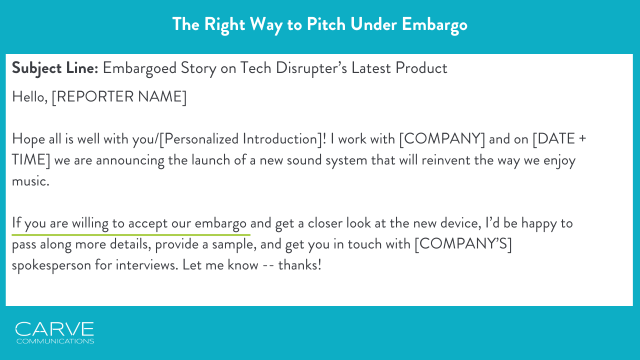Breaking Down PR Embargoes
Written by Rylie Miller
To embargo or not to embargo?
That is the question many PR pros and journalists are (and have been) debating.
Embargoes have been sitting in the hot seat for a while.
Some reporters appreciate the heads up as it can be a worthwhile opportunity that falls into their lap, grateful for the window of lead time. Others may roll their eyes at a pitch with “EMBARGO” plastered in the subject line and send the email to the trash.
So, let’s take a look at the double-edged sword that is media embargoes. Here’s what you need to know about them and when to use them.
What is a PR Embargo?
An embargo is a request, and later an agreement, from a source that the information provided to a reporter is withheld until a specific date and time.
The “source” is usually a PR professional at a brand or their agency and the “information” at hand is something new that a brand is announcing. It can be anything from a company acquisition, to a funding round or new product, research report, or big-time hire.
PR embargoes only “work” with trust between both parties.
If you send your media targets all of the juicy details before they agree to an embargo pitch, they can do ~whatever~ they want with the information. Without an agreement, a reporter is not legally or ethically bound to keep your information confidential.
With that in mind, let’s break down the difference between “pre-pitching” and “pitching media under embargo.” It boils down to this: all pitching under embargo is a form of pre-pitching, but the reverse isn’t true.
→ When pre-pitching: PR pros reach out to journalists BEFORE sending explicit information to gauge their interest. Pre-pitching doesn’t necessarily have to be tied to holding something until a specific date or a traditional news announcement. For example, you could pre-pitch a sustainable thought leadership angle on social, get some interest, and then follow up via email with more information. Think of it as a way to get your foot in the door with media before spilling the beans.
→ When embargo pitching: All initial requests for embargo are a form of pre-pitching. You send them some information on the news and only share the full details after they agree that any potential story is not published until the decided date and time.
PRO TIP: Let’s add another term to the mix: exclusives. When it comes to embargoes vs. exclusives, they are not interchangeable even though some think they are. An exclusive is offered to one specific journalist or media outlet before it is shared with others. They run the story and only afterward do you pitch others. Exclusives may or may not require an embargo depending on the nature of the announcement.
PR Embargo Pitch Example
You must find the balance between sharing enough information to get the media interested without giving away too much right out the gate. As PR Daily’s editor, Allison Carter puts it, “Either make sure you know your reporter well or be a bit more cautious before sending over all you have.”
The Benefits of PR Embargoes
When you do have news that requires an embargo, the heads-up can be beneficial to reporters.
Reporters are pressed for time, and giving them more time to work on a news story shows you respect and understand their work. Media embargoes can be helpful for publications that don’t have the resources to jump on every instance of breaking news.
They can decide how they want to shape the narrative and who they need to talk to for further commentary. They can also conduct interviews and follow up with the PR pro on any additional support they may need. When the embargo lifts and they’re the first out the gate with the story, it gives them an edge against the competition.
If you pitch a reporter the news the news the day of the announcement, they may not have the capacity to cover it. Or by the time they dig in, write up a story, and send it to their editor for approvals, the timeliness has worn off.
“Giving reporters the courtesy of a heads up and the time to work the story into their schedule, quote the right people, and do their own research shows that you’re a good partner and source,” Carver Caroline Phipps said.
In some instances, embargoes can help strengthen your relationship with specific reporters because they show you trust them and follow their coverage. On the flip side, the PR pro is seen as a credible source for future stories; they know they can reach out to you again.
PRO TIP: Sometimes giving a work-in-progress press release to the reporters you have a strong working relationship with can be a good move. It shows you trust them. Of course, tread lightly and follow your gut in these scenarios.
A product-review embargo gives reporters early access to a product or service as long as they keep the review under wraps until the release date. Carver Matt Burkey has seen positive results with consumer media.
“The key element is allowing the media to test something before the public can. You also have extra assurance that the embargo won’t be broken because there is less incentive for the media to post a review before the embargo date without a call to action, like a purchase link. If a reader can’t purchase immediately after the positive review, it takes away from the media’s affiliate opportunities.”
Does My News Warrant a PR Embargo?
As exciting as your brand’s information may be to you and your team, embargoes are necessary if the news you have is…well, actually newsworthy.
Here are some questions to consider:
Is it going to change the lives of a large community or customer base? How?
Was there a breakthrough in research or innovation?
Can you tie it to a current trend or does it go against the grain of what’s accepted as the norm?
Does it involve a large corporate announcement like M&A or a new CEO?
Bonus points if you have:
Brand spokespeople prepared to go on the record
Customers willing to provide their testimonials
Success metrics you can share
If the announcement you’re sitting on is checking off the boxes above – then it may warrant offering up an embargo.
If your “news” falls into one of the buckets below, sorry to break it to you, but it’s not newsworthy or embargo-worthy:
A new board member
Participation in an industry event
An award win
Something that’s already accessible to the public
PR Embargo Watchouts
Embargoes work when used sparingly. If you are constantly pitching reporters by teasing embargoed news that isn’t worthy, that will deteriorate both your and the brand’s credibility.
Beyond over-relying on embargoes, here are a few different other caveats:
An Accepted Embargo Doesn’t Always Equal Coverage
Embargoes do not guarantee coverage. Never have, never will.
“Just because a reporter agrees to the embargo, it doesn’t guarantee a story. They need to review the release or information at hand and decide for themselves,” Phipps said.
Assuming that a reporter will cover your brand simply because you have embargoed information can come off as presumptuous when reporters are inundated with potential news to cover. According to Muck Rack’s State of Journalism 2024 Report, 46% of journalists receive six or more pitches per day. Think about how that adds up every week.
It’s very much a case-by-case basis situation. One reporter might see receiving a request to embargo as a positive, and another might see it as a turnoff. Knowing that they’re just another number on a list of media targets that are also receiving the same request makes the opportunity less valuable since they likely aren’t going to be the only ones covering it if/when they accept.
PRO TIP: Be intentional about who you pitch. Target only journalists and outlets you have an established relationship with and who have a track record of respecting embargoes. Focus on those whose audience and beat align closely with your news.
Time is Always of the Essence
Timing is a big caveat when it comes to pitching embargoes. “The ideal timeframe for an embargo is an absolute minimum of two weeks. If you can go longer than that, it’s better,” Burkey said. “But it also has to do with what you’re announcing and how much additional research the reporter will need to do in order to make the story what they want it to be.”
Life is unpredictable, and unexpected challenges are bound to arise in any given project. When going about an embargoed pitch, be 100% confident that everything is in place on that given date and time.
“Moving the date on embargoes is going to irk reporters more than anything,” Burkey said. “It ultimately creates more work for everybody – having to go back to however many reporters you’ve reached out to and ask them to hold onto it, hoping they saw your email. When you set the embargo, be confident in your news and timing.”
Risk of the Embargo Getting Broken
One of the biggest risks with embargoed news is that they may get broken. This means someone jumps the gun and hits publish before the agreed-upon date.
The breaking of an embargo can undermine the efforts of other journalists who agreed to respect it. When something goes out too early, everyone else comes across as late. This not only leads to frustration between the media and the brand, but the breach of information could cause legal concerns, reputation damage, and lost credibility.
In the inconvenient event that an embargo is broken, move quickly to clean up the mess. Asking the reporter to remove the story is the best place to start. But it’s the way you reach out that will set the tone of an already uncomfortable situation.
“There was an incident where a journalist broke an embargo, and thought he was doing so in good faith. Instead of taking a moment to take a breath and work out my response, I probably wrote it a little more aggressively than I intended it to,” Burkey said. “But I immediately acknowledged it. The journalist took the story down and republished it when the embargo lifted. We still find ways to work together today, but that was certainly a mistake and learning I’ll never forget.”
If you’re unable to get in touch with the reporter or aren’t hearing back anytime soon, alert all stakeholders involved in the announcement as soon as possible. This way they aren’t finding the leaked news in the wild. Stay in close contact with them on the next steps in mitigating the broken embargo.
In the meantime, do what you can to control the narrative – is there a way to play it to your advantage? You can:
Reach out to the other outlets you’ve been in talks with and let them know about the breach, encouraging them to release their stories sooner
Offer follow-up interviews with your spokespeople to add more color to the story
Adjust your strategy based on the early, unanticipated coverage
Media embargoes are clearly intricate. Like many things in the PR and marketing world, it’s not a black-and-white world. But with an intentional and proactive approach – and the right piece of news – embargoes can give your brand an edge in a busy media world.







